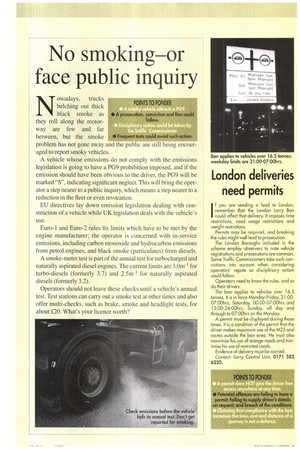No smoking—or face public inquiry
Page 47

If you've noticed an error in this article please click here to report it so we can fix it.
Nowadays, trucks belching out thick black smoke as they roll along the motorway are few and far between, but the smoke problem has not gone away and the pLit)lic are still Heing clkoLtI aged to report smoky vehicles.
A vehicle whose emissions do not comply with the emissions legislation is going to have a PG9 prohibition imposed, and if the emission should have been obvious to the driver, the PG9 will be marked "S", indicating significant neglect. This will bring the operator a step nearer to a public inquiry, which means a step nearer to a reduction in the fleet or even revocation. POINTS TO PONDER
• A prosecution, conviction and fine cou follow. . , • Frequent tests could avoid su on
EU directives lay down emission legislation dealing with construction of a vehicle while UK legislation deals with the vehicle's use.
Euro-1 and Euro-2 rules fix limits which have to be met by the engine manufacturer; the operator is concerned with in-service emissions, including carbon monoxide and hydrocarbon emissions from petrol engines, and black smoke (particulates) from diesels.
A smoke-meter test is part of the annual test for turbocharged and naturally aspirated diesel engines. The current limits are 3.0m' for turbo-diesels (formerly 3.7) and 2.5m-1 for naturally aspirated diesels (formerly 3.2).
Operators should not leave these checks until a vehicle's annual test. Test stations can carry out a smoke test at other times and also offer multi-checks, such as brake, smoke and headlight tests, for about £20. What's your licence worth?




















































































































